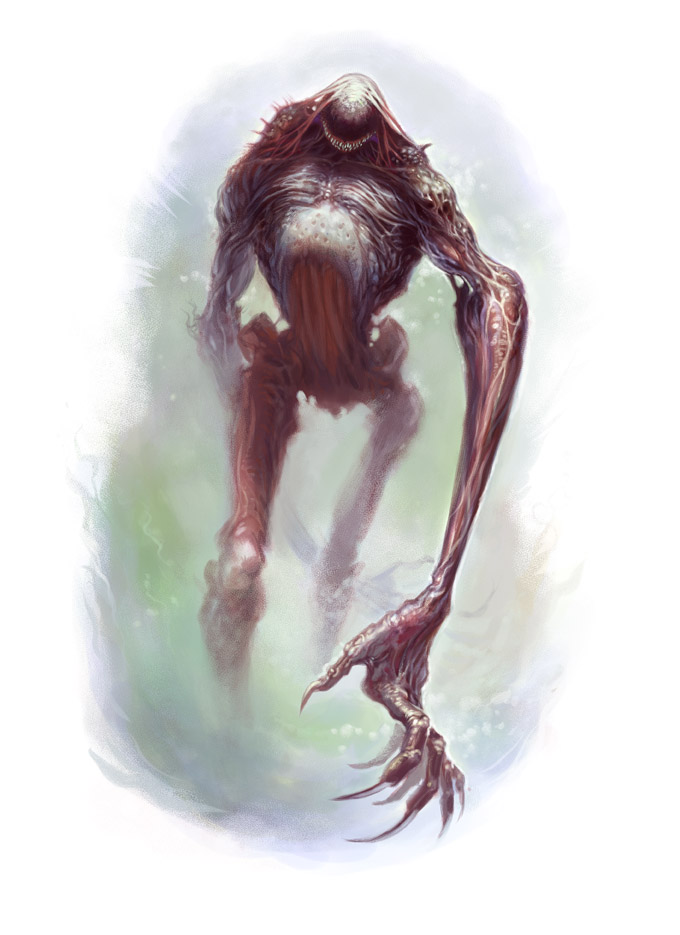Dimensional shambler
- For other meanings of "Shambler", please see Shambler (disambiguation).
A dimensional shambler is an outsider capable of, and innately skilled in, planar travel.1
Appearance
While resembling a humanoid, its eccentric, shambling movement suggests some sort of physical or mental impairment that masks its deceptive alien agility. A typical dimensional shambler is seven feet tall and weighs 350 pounds.1
Ecology
Like other outsiders, dimensional shamblers do not need to eat or drink. They have no special abilities to protect them from exposure to hostile environments, whether mundane or magical, but can innately avoid traveling to realms that would endanger them. They are possessed of a constant drive to explore the planes, and this drive forms the crux of their needs and wants.1
Dimensional shamblers are as askew mentally as they are physically, thinking in manners and angles that defy mortal expectations. Their unexplained need to explore other planes is commonly believed to be curiosity, but it may instead be in service to some unknown goal, a form of strange nutrition, or even a pleasure-fueled addiction. Attempts to open metaphysical discussions with dimensional shamblers, whether to learn about their motivations or to gain their insight on other matters, are limited by their brutish intellects, as well as their instinctive hostility against all other creatures.1
Habitat and society
Due to their innate ability to move between planes, dimensional shamblers can be found nearly anywhere in the multiverse. They wander as they will, stopping only when something catches their interest. Such subjects are typically unusual planar phenomenon, and a dimensional shambler can spend weeks or years in silent observation before moving on. They prefer to dwell on planes either without an alignment or one close to chaotic evil. They also avoid planes and areas with hazards harmful or lethal to them, but older and stronger shamblers typically seek out protective equipment to broaden their potential horizons.1
Dimensional shamblers are loners by nature. They have no desire to seek out others of their kind, but bear no enmity should they encounter each other by chance. By contrast, they display a particular sadism against all other sapient creatures. If a creature is capable of comprehending its own peril, dimensional shamblers take particular pleasure in abducting them to the far corners of the multiverse. What they do to such victims afterwards is unclear, but it is known they play some key role in their ultimate demise, and the few survivors of such abductions always escaped or killed the dimensional shambler that took them. Many victims who manage to escape undoubtedly perish anyway, as dimensional shamblers favor remote and dangerous places as their destinations.1
On Golarion
The difficulties of mortals attempting planar travel often inspires them to summon dimensional shamblers to take advantage of their powers. One method of summoning them involves blood sacrifice rituals involving a pure metal blade, mathematics, and runes. Specific combinations are tied to individual dimensional shamblers, leading to the spellcasters who discover such details to hold them as treasured secrets.1
The Book of Abstruse Geometries, an ancient discourse on the secrets of the Dark Tapestry, has directions for summoning one of a hundred named dimensional shamblers.23
Abilities
Despite their unrefined intellects, dimensional shamblers have an instinctive mastery for the magic of planar travel. For their own use, this allows them to easily step between nearby points on the same plane and travel between planes with such mastery that they can drag along unwilling victims. This knowledge also makes them extremely adept at countering the magic of others. They can simply negate most summoning spells with impunity and resist planar bindings with the skill of far stronger creatures, replacing raw power with specialized knowledge. They can also struggle against effects that would typically restrict the use of teleportation and planar travel in the same way one could struggle against physical bonds, often with enough success to temporarily slip their hold.1
References
- ↑ 1.0 1.1 1.2 1.3 1.4 1.5 1.6 1.7 . “Bestiary” in Wake of the Watcher, 80–81. Paizo Inc., 2011
- ↑ . Wake of the Watcher, inside front cover. Paizo Inc., 2011
- ↑ . “Wake of the Watcher” in Wake of the Watcher, 38. Paizo Inc., 2011
